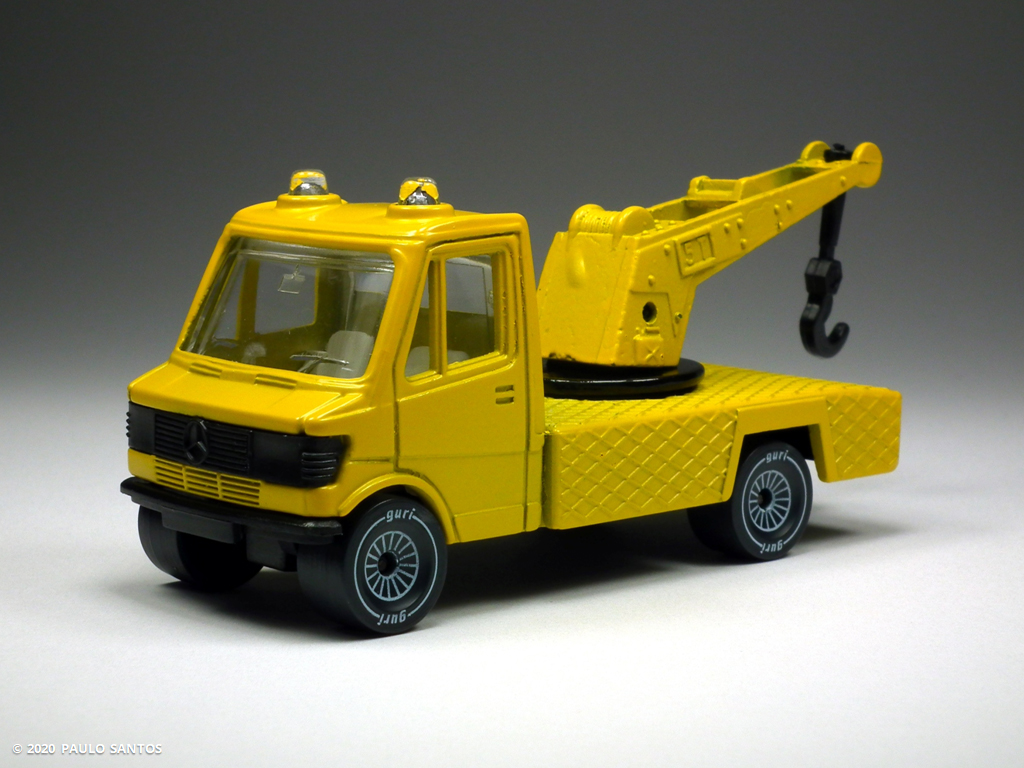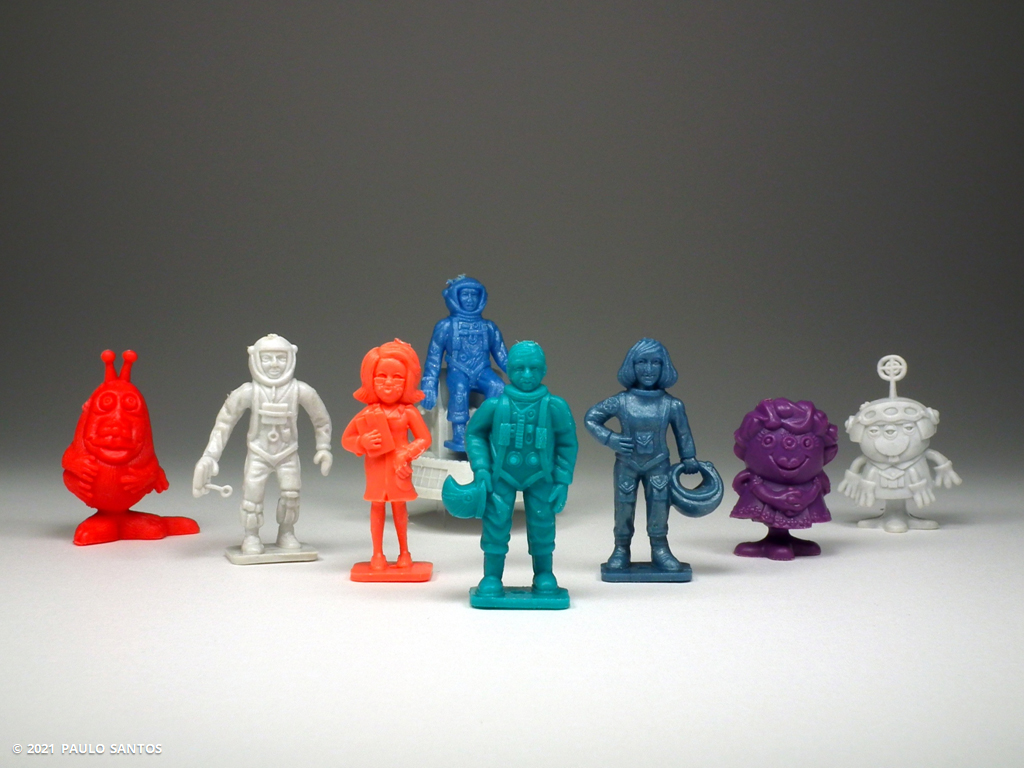Poliguri – Mercedes 307 Tow Truck
Scale model of a tow truck, the Mercedes 307, made by Poliguri. This example is reference 707, included in the "Guri Car" series. It is made in Portugal, possibly between the late 1980s and the mid-1990s. Metal cab and platform painted in yellow, metal crane in yellow with base in black, black plastic hook. Black plastic base. Glazing represented in transparent plastic, with details such as the windshield wipers and the rear-view mirror molded on the windshield. Transparent plastic lights on the roof (rotating beacons). Interior details in white plastic. Plastic wheels (R16) with printed details in white suggesting the rims, white line printed on the tire wall cut twice by the word "Guri". No suspension. Tow hitch. Swiveling crane. The nominal scale is 1:65 and the overall length, with boom projection included, is approximately 3.3 in. About 1.8 oz. In the "Guri Kit" series, reference 700 N, this tow truck comes with a small trailer. This model represents a tow truck, possibly based on the 1982 Mercedes-Benz 307 D, with a gross weight of 7,055 lb and equipped with the 53 kW (72 hp) Mercedes-Benz OM 616 engine. It is made by Poliguri in several color variants.
On the 1988 catalog, Poliguri describes this reference as a "Mercedes 307". However, on the base of the model we can read "Mercedes 207". There is clearly a lapse here. I don’t know which description is right, but until someone comes out with a documented answer, I stick with the provisory option I feel is more reasonable. The Mercedes-Benz 207 D and 307 D are identical, except for the gross weight, which is higher in the latter, 7,055 lb against 5,622 lb, making it more credible for supposed towing tasks – even in a miniature world. So, for now, my option is "Mercedes 307". An interesting note, this is the only Poliguri reference with a plastic base. This tow truck, the Mercedes 307, is in my collection under the themes "German Vehicles" and "Vans & Pickup Trucks". ●
Modelo à escala de um pronto-socorro, o Mercedes 307, feito pela Poliguri. Este exemplar é a referência 707, incluída na série "Guri Car". É feito em Portugal, possivelmente entre o final dos anos oitenta e meados dos anos noventa. Cabina e plataforma em metal pintadas em amarelo, grua em metal pintada em amarelo com base em preto, gancho em plástico preto. Base em plástico preto. Vidros representados em plástico transparente com detalhes como os limpa pára-brisas e o espelho retrovisor moldados no pára-brisas. Luzes no tejadilho (rotativos) em plástico transparente. Detalhes interiores em plástico branco. Rodas em plástico (R16) com detalhes impressos em branco a sugerir as jantes, linha branca impressa na parede do pneu cortada duas vezes pela palavra "Guri". Sem suspensão. Dispositivo de reboque. Grua giratória. A escala nominal é 1:65 e o comprimento total, com a projecção da lança incluída, é de aproximadamente 83 mm. Cerca de 50 g. Na série "Guri Kit", referência 700 N, este pronto-socorro vem acompanhado por um pequeno atrelado. Este modelo representa um pronto-socorro, possivelmente baseado na Mercedes-Benz 307 D de 1982, com um peso bruto de 3,200 kg e equipada com o motor Mercedes-Benz OM 616 de 53 kW (72 hp). É feito pela Poliguri em diversas variantes de cor.
No catálogo de 1988, a Poliguri descreve esta referência como um "Mercedes 307". No entanto, na base do modelo podemos ler "Mercedes 207". Há claramente um lapso aqui. Não sei qual é a descrição que está certa, mas até que alguém apareça com uma resposta documentada fico com a opção provisória que considero mais razoável. Os Mercedes-Benz 207 D e 307 D são idênticos, excepto pelo peso bruto do veículo, que é mais elevado no último, 3,200 kg contra 2,550 kg, tornando-o mais credível para supostas tarefas de reboque – mesmo num mundo em miniatura. Por isso, por agora, a minha opção é "Mercedes 307". Uma nota interessante, esta é a única referência Poliguri com a base em plástico. Este pronto-socorro, o Mercedes 307, encontra-se na minha colecção sob os temas "Veículos Alemães" e "Carrinhas & Camionetas". ●
1 mm → 0.039 inch
1 g → 0.035 oz
1 kW → 1,360 hp (metric)
1 kW → 1,341 hp
1 hp (metric) → 0,986 hp
1 km → 0,621 mile (international)
Poliguri "Guri Car" series
The "Guri Car" series comprises at least 14 references, including the Unimog, several versions of the Mercedes-Benz TN, the Mercedes-Benz 200, the Fiat Uno and the Peugeot 405 Prototype. Check out other Poliguri references here. ● A série "Guri Car" compreende pelo menos 14 referências, incluindo o Unimog, diversas versões da Mercedes-Benz TN, o Mercedes-Benz 200, o Fiat Uno e o Peugeot 405 Prototype. Confira aqui outras referências da Poliguri.
Versions and color variants
Color variants that I know are red, orangey yellow, yellow, green and blue, with the crane painted to match. The base of the crane is usually black. The hook is always black and often missing on played with examples. I have seen reference 707 with white interiors only. Always fitted with R16 wheels. Painted roof lights, not always in the right color, in this case, orange, are the work of enthusiasts. Wheel transplants are quite easy to perform on this model. Necessary corrections or additions to the above are welcome. ●
As variantes de cores que conheço são em vermelho, amarelo alaranjado, amarelo, verde e azul, com a grua pintada a condizer. A base da grua é normalmente em preto. O gancho é sempre preto e muitas vezes em falta nos exemplares brincados. Tenho visto a referência 707 apenas com interiores brancos. Sempre equipada com rodas R16. Luzes no tejadilho pintadas, nem sempre na cor adequada, neste caso, o laranja, são o trabalho de entusiastas. Transplantes de rodas são bastante fáceis de realizar neste modelo. Devidas correcções ou adições ao acima descrito são bem-vindas. ●
707 Yellow cab and platform, yellow crane with black base. White interior.
Below, an image originally published on the website "MY POLIGURI COLLECTION". As we can see, the towing operation is possible, albeit somewhat delicate. ● Abaixo, uma imagem originalmente publicada no website "MY POLIGURI COLLECTION". Como podemos ver, a operação de reboque é possível, ainda que algo delicada.
The 1:65th scale model made by Poliguri in the 1980s and its inspiration, the Mercedes-Benz 307 D. Here we see a longer version, possibly the one with a 12.1 ft wheelbase. Despite the obvious liberties taken with proportions and details, I think the "character" of the TN is there. And, like the prototype, the miniature is robustly built – and made to last. Photo of the Mercedes-Benz 307 D courtesy of © Mercedes-Benz AG. Photo preserved in the Mercedes-Benz Classic Archives. ●
O modelo à escala 1:65 feito pela Poliguri nos anos oitenta e a sua inspiração, o Mercedes-Benz 307 D. Aqui vemos uma versão mais longa, possivelmente aquela com uma distância entre eixos de 3,70 m. Apesar das óbvias liberdades tomadas com proporções e detalhes, penso que o "carácter" da TN está lá. E, como o protótipo, a miniatura é construída de maneira robusta – e feita para durar. Foto do Mercedes-Benz 307 D cortesia © Mercedes-Benz AG. Foto preservada nos Mercedes-Benz Classic Archives. ●
References
FM – TOYS & MODELS | "Poliguri – Brief Introduction"
FM – TOYS & MODELS | "Poliguri – Breve Introdução"
FM – TOYS & MODELS | "Poliguri – Spot the Difference"
FM – TOYS & MODELS | "Poliguri – The Playwell Connection"
FM – TOYS & MODELS | "Poliguri – Wheel Types"
FM – TOYS & MODELS | "RESEARCH – Poliguri References"
Wikipedia | "Mercedes-Benz TN"
Mercedes-Benz | "Vorstellung der neuen Transporter-Reihe TN"



















Comments
Post a Comment